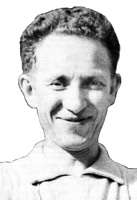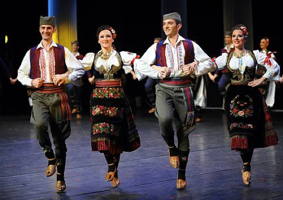
|
The Society of Folk Dance Historians (SFDH)
Folk Dance Situation
[
Home |
About |
Encyclopedia | CLICK AN IMAGE TO ENLARGE |

|
Many folk dance leaders are continually confronted with the concern of new dances for the new camping season. Some, to overcome this demand, or what they imagine is demanded from them, restore to the creation of a type of round dance, or actual round dance or synthetic folk dances to folk or popular tunes. Thus, the folk dance movement is faced with a problem. How much better it would be to teach the new generation of folk dancers the dances that have been popular a dozen or more years ago which has given the old timers so much pleasure but now are done no more, instead of adulterating the folk dance movement with novelty numbers. There are plenty folk dances that contain the novelty element, too, and are by far more enjoyable and interesting. Let's retain them.
ISRAELI DANCES
The newest dances from Israel likewise constitute a problem. Not because too many of them are appearing on the market but too many versions of the same dances. Many international folk dance teachers in the East refuse to teach the latest acquisitions. Often dances become well established here in two or three versions (or even more) when the originator of these dances reaches these shores and teach an "original" version. Confusion ensues. Zafra Thatcher opined that the versions are made up by the Israeli students on the boat before reaching the American shore. Those who visited Israel, including Rickey Holden, who came back with an overly enthusiastic report on the Israeli dance situation, claims the very creators of the dances never teach the same dance the same way twice. Each time it is re-instructed by them they do it differently. Those, depending who was where at which class, are the one who spread versions. Plus the fact that Israeli students in this country will always improve and shamltz-up the Israeli dances no sooner their teacher leaves, helps matters none. Therefore, most clubs just stick to the old "pre-Yemenite" dances such as Mayim, Harmonica, Ken Yovdu, Mechol Ovadya, etcetera, and feel they are on safer ground (maybe).
KOLO PROBLEMS
 The interest in Kolo dancing has grown tremendously to a point where many international folk dancers are becoming greatly disturbed and many have undertaken to study the problem of why.
The interest in Kolo dancing has grown tremendously to a point where many international folk dancers are becoming greatly disturbed and many have undertaken to study the problem of why.
The most often worried question asked of me by various leaders everywhere, and practically using the same coined adage, is "What are they trying to do, kill the goose that laid the golden eggs?" In many instances the Kolo dancer is divorcing himself completely from the folk dance. At many festivals it was noted that they will refused to go upon the floor to do any old standard dance which seemed a favorite in pre-Kolo days. I've seen a floor full of people, well over a hundred (on the West coast) where the leader had to beg to form at least one square for the Italian Quadrille, which was next on the program. But if the exhaustive Eleno Mome was put on then they all ran out with shouting an whooping, dancing it with fury, and were it repeated they would be there again. They'll never tire of the monotonous dances where for a few measures one runs five steps and then shakes three times, but comes the next time he doesn't run any more, now he'll walk five steps and shake three times.
The fear remains that it will spread to even folk dance strongholds with the attendance of physical education teachers in camps and by the new neophytes who never get to learn the international folk dance and the old standard standbys. This may be one of the reasons why there are no takers for the folk dances, simply because the neophytes have never learned them. What is mostly sad, I've observed to be true everywhere, New York, Cleveland, etcetera, that the most ardent Kolo-fiend and loudest praiser of this type of dance, can't dance a Waltz, a Polka, a Schottische, a ambo, in fact, not even a graceful Kolo. He appears like a clumsy ox on the floor, and he can't dance with a woman partner! He doesn't even know how to face her. This is true of all the newly exposed Kolo dancers, not the old timers who had a good upbringing in the folk dance field and background. These often dominate a dance floor and continually demand more. Even at Jane Farwell's stronghold, as one complained (the Jane who championed for simple and recreational folk dancing of an international scope), at Mount Horeb camp, kolomaniacs came down with tapes of Kolos demanding that the fare of the evening be it!
One wonders if the international dance world was not happier when only few Kolos were known, the original old Kolos. For all these new Kolos are but variations of the old standards. The Šetnjas, the various Narodnos, and the likes, are but the old Sarajevkos, others are watered down or rearranged Žikinos, others are worn thin with rearrangements of U šest steps, others are rearrangements of the ordinary Hasapikos. In those days, the basic "mother" Kolos were known and there was room for other dances which made the folk dancer a truly international folk dancer. Nowadays, it seems to be the Kolo dancing plus "others," as was on a request board. One half of the board had it "Kolos," the other half had it "Others," meaning folk dances. As soon as a Kolo was danced, the name was obliterated and immediately replaced. This is a good indication of where the folk dance was relegated.
What remains to be done? The leaders will have to take this matter in their hands. If he is any sort of a sensible leader he will select the program wisely and without favoritism to any one type of dance. It is different matter when one attends a Kolo festival and and it is another thing when one attends an international folk dance. The repertoire is tremendous and a whole evening or afternoon can consist of truly international dances without need to repeat a nationality for more than twice, including Yugoslavia. Much too many beautiful and recreational folk dancers can't participate. Or else, precede the program with a fifteen-minute session of Kolos and let them get off the steam. Kolos are wonderful, but we must remember we are NOT an ethnic Yugoslav group, but INTERNATIONAL FOLK DANCERS.
QUALITY OF DANCING
The deterioration in the Southern Californian area among the Folk Dance Federation of California, South, groups has troubled me greatly for a year. I was made aware of it many times during my tour when Easterners who visited the Southland reproached me (as if I have anything to do with them or have any voice as to how they shall dance within their groups) by saying, "They dance terrible in so-and-so."
Indeed they do. But these claim that having a good time is more important than dancing well. It is usually the Kolo that suffers most. Some of the indignities perpretrated upon the poor Kolos would cause Dick Crum to scream "Gewolt!"
The Germans say, "Du viel ist ungesund" (anything too much is unhealthy). Moderation is still the best policy. Let's not overdo with our Kolos for we WILL kill the "goose." Let's not overdo with good timing at the expense of good dancing. Let's include the proper style with the proper dances. Let the Federation, whether in Northern California, Southern California, Minneapolis, Seattle, or Hotzeplotz, take more interest in their member groups and encourage (if not insist) upon good dancing, and let the Federations not be merely dues-collecting agencies. Let the various leaders reach an agreement allowing conflicting parties to coexist among themselves (there is still too much back biting, bickering, and jealousies among and especially in the east!). If they would but overcome their personal hatreds and feelings of superiority and direct their energies toward more important problems that concern the folk dancers, how much happier things would be. If there is bliss among leaders, can one expect fellowship and brotherliness among their students? Let us have a good time dancing but, at the same time, let's not insult the nationality by malforming their dances, which is their precious heritage of ages past. Let's get more people to do international folk dances and leave the ethnic dances for the ethnic groups, or specializing groups who can cope with problems and understand or appreciate the style demanded from an ethnic form of dance. But, above everything, make folk dancing an enjoyable and needed exercise of clean fun replete with neighborliness and good fellowship.
DOCUMENT
- Vyts Beliajus, an article.
Excerpts are taken from "Dance Situation 1958" by V. F. Beliajius
Viltis Magazine, December 1958, Volume XVII, V. F. Beliajius, Editor.
This page © 2018 by Ron Houston.
Please do not copy any part of this page without including this copyright notice.
Please do not copy small portions out of context.
Please do not copy large portions without permission from Ron Houston.